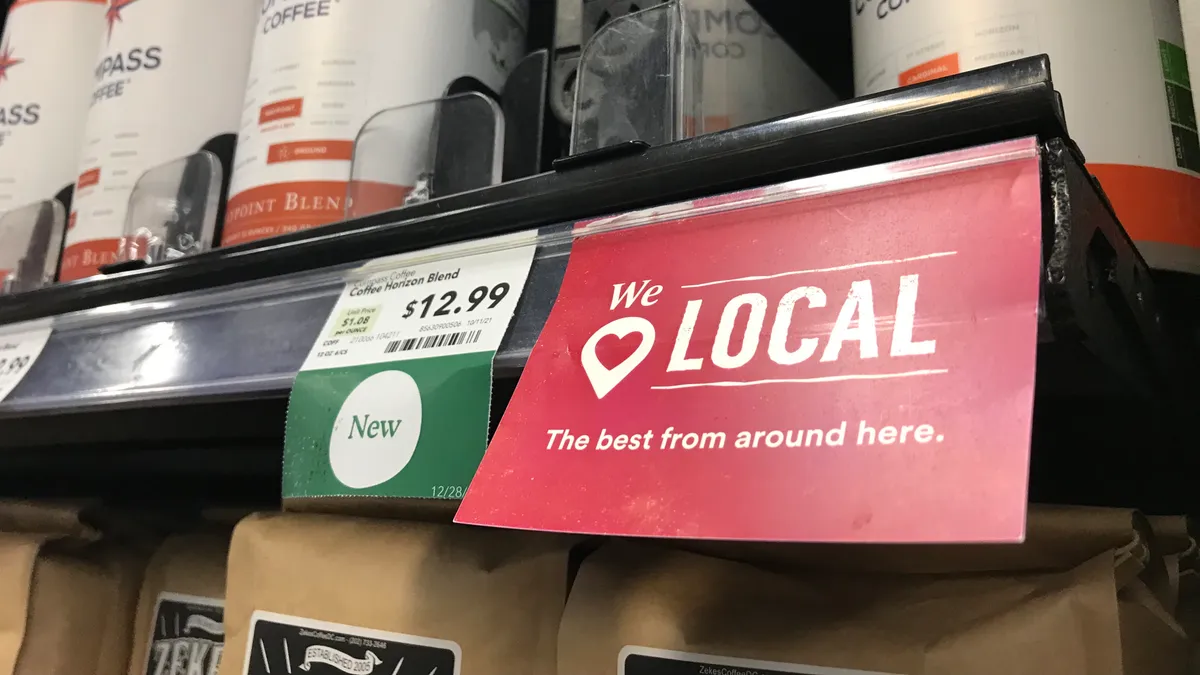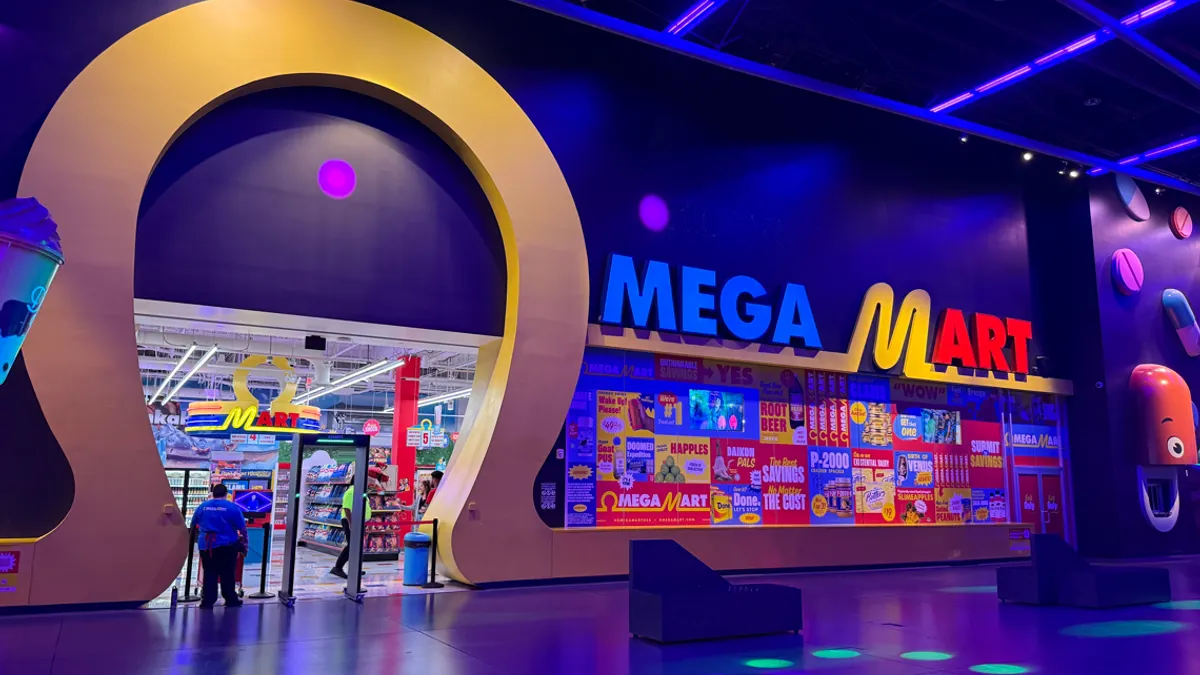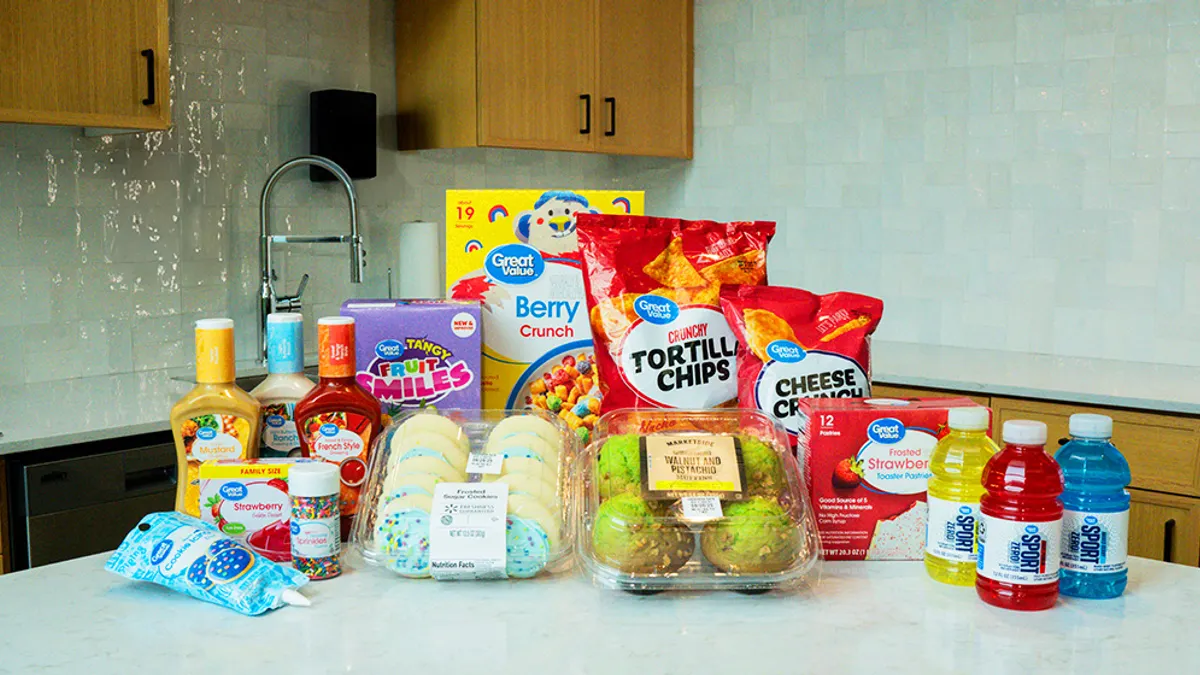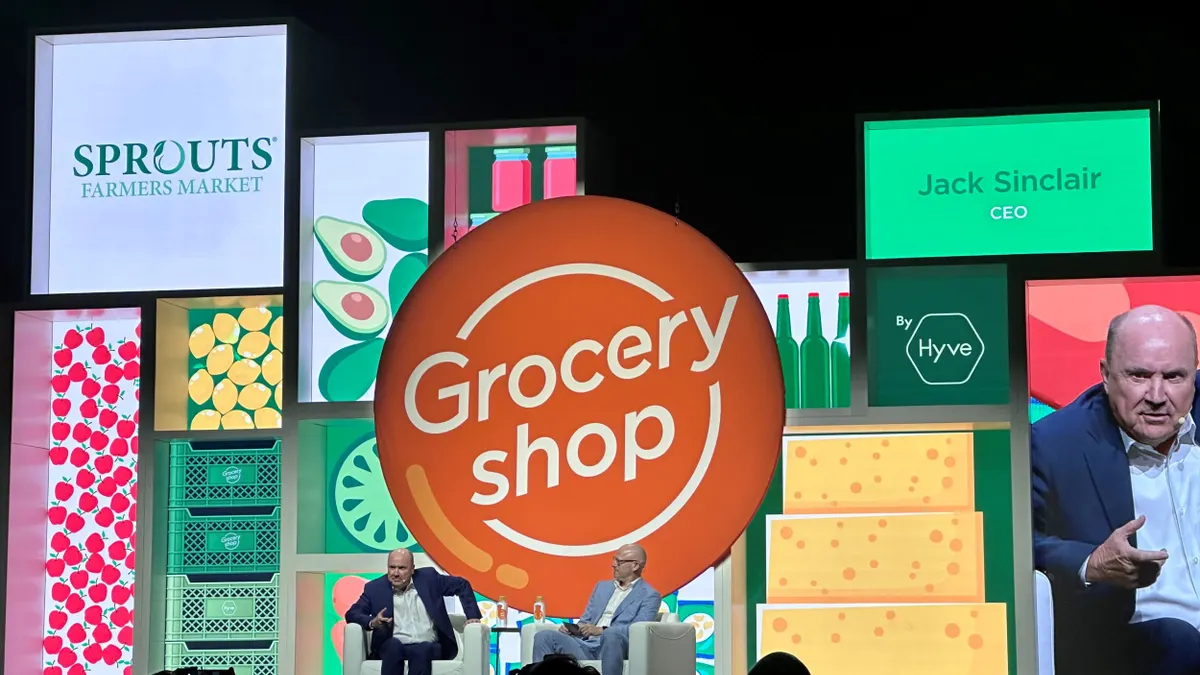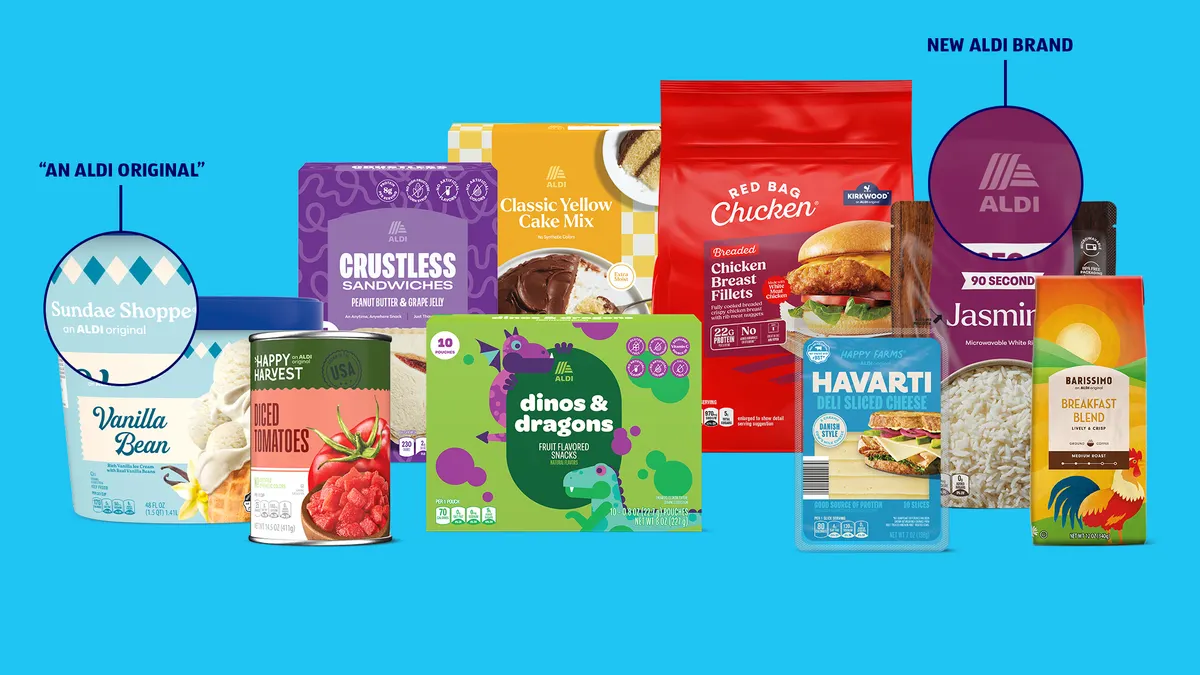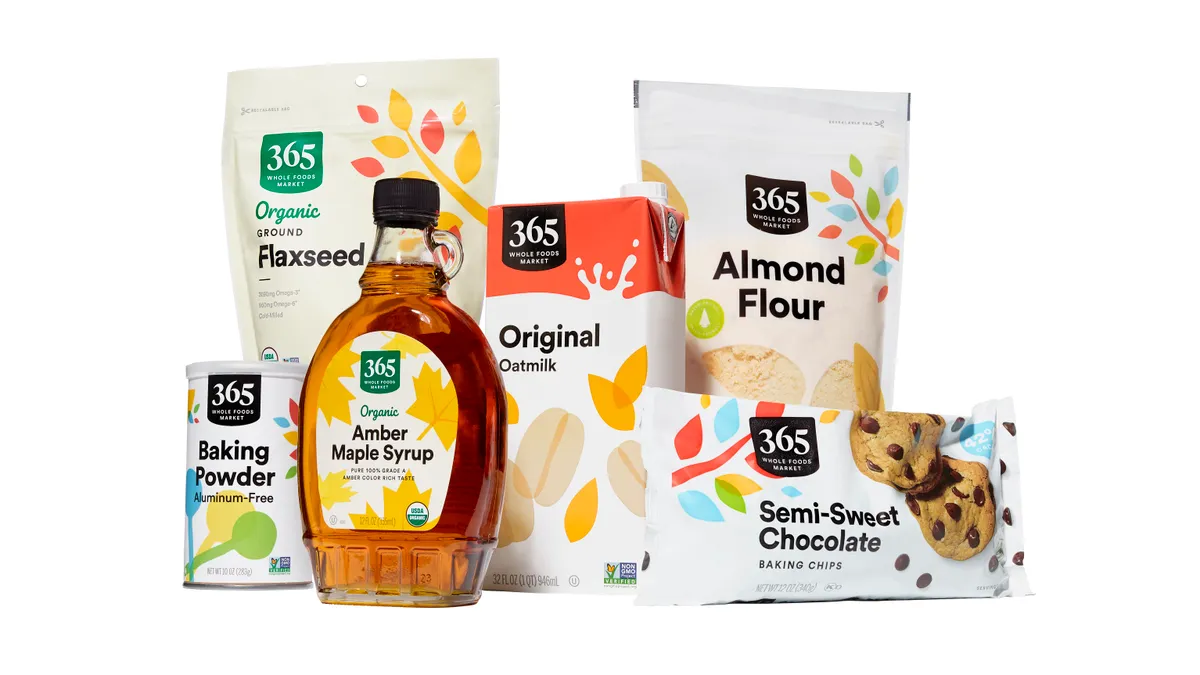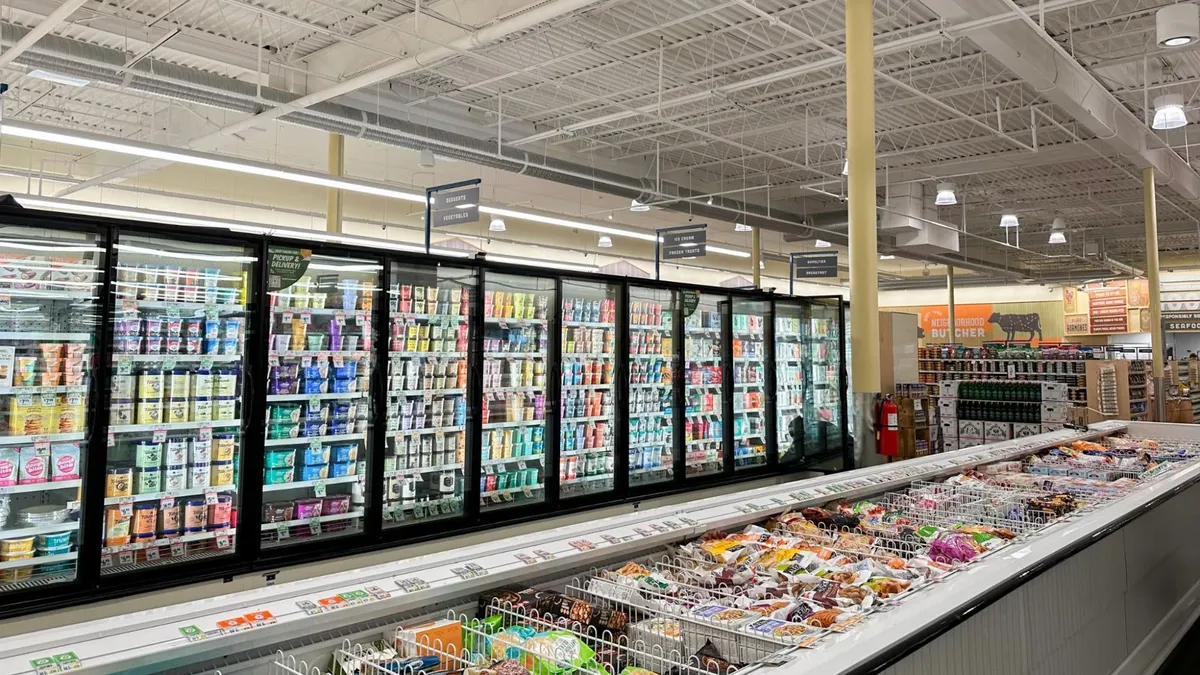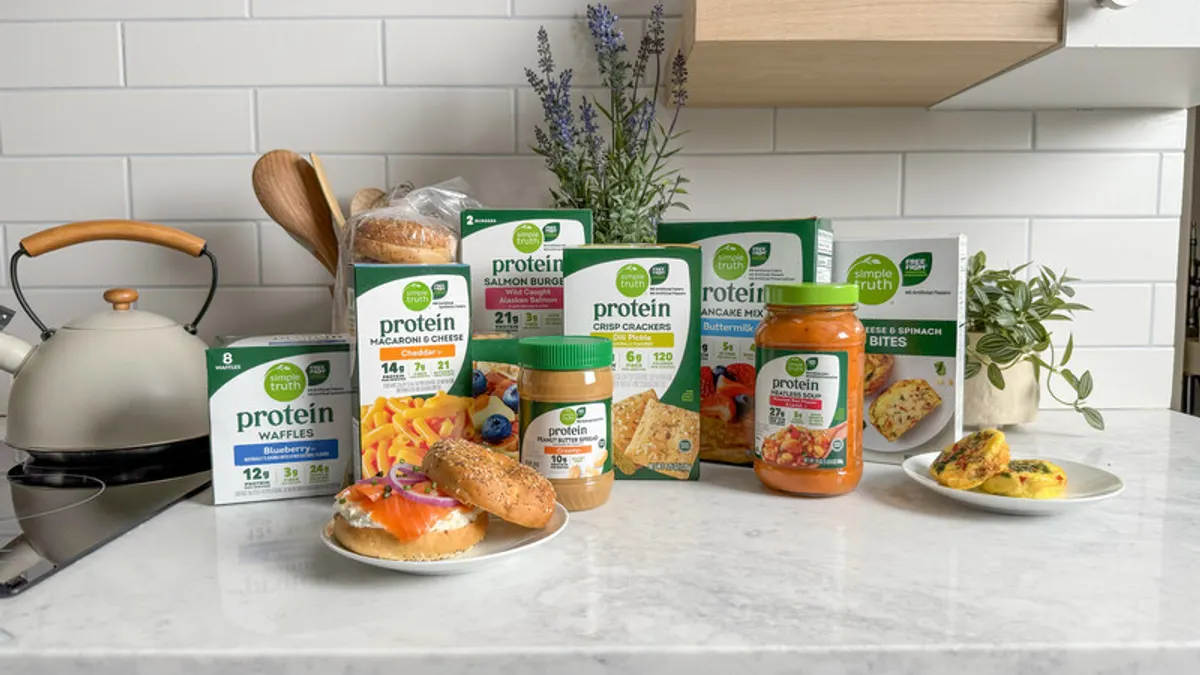This article is the second in a four-part series exploring the opportunities and challenges retailers face in center store. Next week, Grocery Dive will explore e-commerce personalization and store design opportunities. The full series is posted here.
Bashas’ has been carrying local products for nearly 90 years, but this year the Arizona-based grocery chain decided to go all-in on accelerating its sourcing and merchandising efforts.
In addition to sourcing more products from Arizona, Bashas' redesigned its local shelf tag to say “Local Like Us” alongside the Arizona state flag. “I didn’t think [the tag] was loud enough on the shelf … I just felt like we needed this screaming a little bit louder,” said Steve Mayer, Bashas’ senior vice president of marketing, merchandising and procurement.
The company has long wanted to do more with local products, but sourcing has been difficult, Mayer said. So the grocer partnered up this spring with Forager, a company that helps simplify local sourcing for brands and retailers.
Bashas’ is not alone in its efforts — and struggles — to boost local products. Other chain retailers, including Meijer and Kroger, have put out calls for local and emerging suppliers, and are ramping up their sourcing and marketing efforts at a time when local has taken newfound urgency during the pandemic. Global supply chain issues have caused major stock-outs, giving smaller brands opportunities to fill the gaps on the shelf, while consumers have turned more attention to local items for a variety of reasons.
Meanwhile, local sourcing has gotten easier in recent years with the emergence of companies like Forager and RangeMe, founded in 2015 and 2013, respectively, to address grocers’ burdens of finding and vetting suppliers and help brands gain more visibility and access to resources to become shelf-ready.
"What [retailers] knew as their 'world of local' might not have been the actual full scope of what was available to them,” said Brandon Leong, senior vice president of marketing and growth at RangeMe.
So while local is not a new trend for retailers, it's gaining more resources and relevancy as companies confront evolving consumer needs alongside new supply chain realities. Retailers are starting to set targets for local campaigns and commit to permanent local sourcing, turning local into "less of a trend and more of a staple," Leong said.
While usually linked to fresh items, local products are populating shelves alongside private label items as retailers look to diversify beyond national brands. In center store, an area grocers have long struggled to make more exciting for shoppers, local products can boost the treasure-hunt experience within the rows and rows of packaged products, experts say.
Strengthening connections with consumers
Recent research shows that grocers are turning to local products to help differentiate their grocery aisles. In a report issued this fall, The Food Industry Association (FMI) noted that 83% of retailers it surveyed said local assortment throughout the store was a popular differentiator, with 58% of respondents rating the approach as highly successful. Of the 300 grocery executives surveyed by Grocery Dive and Inmar Intelligence in October, more said they plan to add more local or emerging brands (53%) to center store than those who said they plan to increase private label (roughly 32.7%) within the next two years.
Local products tap into community pride and consumer desires to support small businesses and also pique consumer interest with the story behind the product. Even small brands that eventually reach national distribution can still tap into their "local hero story," Leong said, giving the example of Anchor Steam Beer, which is made and beloved in San Francisco.
"If you're a farmers' market all-star, it doesn't really mean that you can make it to shelf."

Brandon Leong
Senior vice president of marketing and growth, RangeMe
“There is a great fascination on the part of consumers who have felt so distant from their food for so long," Forager CEO Joe Blunda said.
Innovation happens a lot faster with smaller brands, whether it's trying alternative ingredients or trying new packaging, said Andrew Criezis, NielsenIQ's head of product for small and midsize businesses.
Whole Foods Market, for example, partners with local brands to help them develop innovative line extensions, Kelly Landrieu, the grocer’s global coordinator of local and emerging brands, wrote in an email. The grocer has included local products in its yearly report on trends and featured items like Ruby Hibiscus Water and Green Bar Distillery Lavender Bitters & Soda in the grocer’s first-ever Trends Discovery Box, which debuted in October, Landrieu wrote.
Consumers often equate local products with being healthier for themselves and healthier for the planet, sources said.
“In the center store, one of the biggest differentiators that's available is 'local' as its own certification of cleaner, fresher, more wholesome foods," Blunda said, adding that "local" adds weight to other claims like "clean" that consumers may be warier of when used by large CPGs.
Tapping local to meet company goals
As sustainability and diverse sourcing have become key goals for grocers, local sourcing has become a way to tap into both of those initiatives. Local products often have a lower carbon footprint because manufacturing operations are often smaller and products have fewer miles to travel.
Leong said there's a connection between small brands and diverse owners, whether minority-, women- or veteran-owned. As equity and inclusion issues have surfaced during the pandemic, grocers are putting more pressure on companies like Forager to help them surface diverse suppliers, Blunda said.
“It's a huge opportunity for CPG because, to be frank, on the fresh side, you can't really flip a switch and diversify that business or that supply chain," Blunda said.
Kroger aims to invest up to $10 billion in diverse suppliers by 2030 and triple its sourcing from diverse suppliers as part of a 10-part plan to advance diversity and equity it released last fall. Earlier this year, Kroger held a competition to expand its sourcing from local and regional growers and producers, giving the winners placement on Kroger shelves as well as ongoing business development from the company and its affiliates.
"People that are diverse have different experiences. Therefore they have different perspectives. Therefore, you can get different ideas, and when you have different ideas, that's where you get innovation," said Angel Colón, Kroger's senior director of diversity and inclusion, multicultural development and supplier inclusion.
During listening sessions the grocer held last year, Black associates pushed the grocer to focus on improving sourcing diversity — something customers have also been pushing for, Colón said. Kroger works with numerous certified organizations, which often have local chapters, to find diverse brands, including the National Minority Supplier Development Council, the Women's Business Enterprise National Council and the U.S. Hispanic Chamber of Commerce, Colón said.
"What happens many times is many of our diverse suppliers have started local," Colón said, adding Kroger has seen local brands turn into national ones.
Shelf placement can be tricky
In center store, categories that typically have an abundance of local products include honey, sauces and spices, sources said. Snacks and non-alcoholic beverages are the areas where Forager is seeing the most dramatic growth, Blunda said.
Local products haven’t really gained ground in the frozen section due to limited capacity or within the wellness category due to the limited number of shelf-ready items and branding challenges, Blunda said. Other categories, like coffee, have had mixed results, with the number of local options and sales strength varying among retailers, sources said.
Whole Foods' local assortment varies by category and city based on product availability and consumer interest, Landrieu wrote. For example, local protein powders and nutrition bars have a higher density in fitness-focused areas.
While center store shelves often don't pose the same space constraints as refrigerator or freezer cases along the perimeter, getting on shelves and gaining prominent placement are still challenges for small brands. In FMI’s report from September, 66% of retail respondents said they were increasing SKU allocation, either in-store or online, of local products — more so than for private label and for organic, gluten-free or health and wellness products. But 68% said they plan to maintain overall space allocation in center store, while 24% plan to decrease it.
With more maturity and volume, large CPGs often command large sections and pay for priority placement in center store, leaving for other brands the space at the top or bottom, which can be hard to reach and out of sightlines. “If you're a farmer's market all-star, it doesn't really mean that you can make it to shelf," Leong said.
Getting on shelves can be cost-prohibitive for small brands, with barriers including slotting fees, requirements for brands to commit to providing a certain amount of product, and pay-to-play shelf access, which can cost thousands of dollars, said Criezis of NielsenIQ. In an effort to make shelf placement more accessible for smaller brands, City Feed and Supply, a grocer with two stores in Boston, doesn't charge local suppliers slotting fees.
NielsenIQ is seeing smaller brands make a bigger impact with shorter-term promotions or with end caps, which can grab shoppers' attention. "Promotions can be very effective," even during inflation, he said. Oftentimes, national retailers will do a trial in a region for a small brand for a few months or a year before determining if and how much it will get expanded, he said. Bashas’, for example, will sometimes wait for a reset to add local products, but other times it will do a plug and play — dropping in a product that's not on a cycle, Mayer said.
How much product a local brand can supply can impact not only how many stores it gets into, but also product placement. “If [there's] enough product selection in that category where it's across multiple shelves, then we will try to give them a more premium location," said David Warner, president and co-founder of City Feed and Supply.
Brands said where their products end up in stores varies from grocer to grocer. Amanda Gilman, founder of AMG Snacks in Massachusetts, said she has seen her energy bites merchandised in the snack aisle, the nut section and on end caps, noting she likes the visibility of end caps but they usually have a cost. “If you just go on the shelf and go in with other products, you get a bit lost,” she said.
Kamaal Jarrett, founder of hot sauce brand Hillside Harvest in Massachusetts, said there are several ideal placements for his products, including the international aisle, the meat aisle and hot sauce section, along with secondary and tertiary placement in areas like seasonal grilling displays and among spices.
Navigating pricing
While price and convenience are top of mind for consumers, the novelty of local items helps them stand out. “I think the customer looks at two products — one’s local and one’s not and they’re relatively in the same price — locally usually wins out,” Mayer of Bashas' said. “I think local is very powerful.”
City Feed has found that customers like having choices at different price points, Warner said. Roughly 40% of City Feed's inventory consists of local products, and, within center store, the grocer aims to offer three to four local or regional brands along with one to two national brands, like an organic option and a lower-priced, generic, per product category to serve customers with different price points, Warner said.
Because consumers tend to equate local with specialty, grocers can often sell local items at premium prices, boosting their margins. Sources said consumers are willing to spend more on local products because they often view them as higher quality and more aligned with specific values.
While smaller grocers have leaned into the premium pricing of local products, small brands often struggle with having the volume needed to lower costs to compete with larger brands on pricing, which is typically a bigger concern the larger the retailer is, sources said.
Combined with the pricing of products sold online directly to consumers, at farmers' markets and on Amazon, Jarrett said it's important to not create too many changes in pricing across those different channels.
“What we’re seeing now is we’re having to be cognizant of where we’re playing with price in each channel. We don’t want to alienate folks," he said. "We don’t want there to be too much parity between pricing, but we also don’t want to be at a specialty price point in large retail grocery chains.”
As sales increase, Jarrett said he expects the prices to come down. Until then, he's playing with promotions as he navigates pricing for products that haven't seen changes in costs yet.
“We’re not in all 86 or so Stop & Shops in Massachusetts. We’re only in 10, so as a result, we’re not getting the benefit of scale just yet, but the price point needs to be in line with what Stop & Shop customers are expecting," Jarrett said.
Because local suppliers have a lot of money tied up in their products, it’s important to get their products on the shelf and selling as soon as possible and then get payments out quickly, Mayer said.
Providing more hand-holding
Though finding and working with local vendors has gotten easier with the arrival of companies like Forager and RangeMe, grocers said smaller brands still need extra assistance. Mayer said Bashas' has had to show them the pack sizes or pick up products as local suppliers have been impacted by the trucking shortage.
Center store, especially, often requires brands to take more steps to become shelf-ready than for the produce department, where the packaging doesn't matter as much, sources said. Becoming shelf-ready requires a long list of steps, including adding insurance, safety certifications, barcodes and nutrition labels.
“We tend to move slower with opportunities because we just are spread so thin. And I think, buyers and managers are aware of it, and as a result, they don't crucify us for it, but I think us as the business owners are more aware of the opportunity that we're missing out," Jarrett said.
“I think the customer looks at two products — one’s local and one’s not and they’re relatively in the same price — locally usually wins out.”

Steve Mayer
Senior vice president of marketing, merchandising and procurement, Bashas'
Once Kroger finds and vets the brands, the grocer has development opportunities, like helping them prep for category manager meetings, offering webinars on business growth and providing coaching, Colón said. Earlier this year, Kroger created a resource guide for small businesses about getting retail-ready, covering topics like pricing, promotions, supply chain and product development.
Whole Foods offers low interest loans through its Local Producer Loan Program, which was created 15 years ago.
Some retailers, like City Feed, also take time to mentor local brands and help them improve their business. Recently, Warner had an hour-long phone call with a potential vendor. Oftentimes, mentoring involves talking about pricing strategies, packaging, what customers want, what grocers want and general business advice, like "make sure you can pay yourself first," he said.
Warner said he takes pride in helping local, small brands become successful, like Effie's Homemade, a Massachusetts-based maker of biscuits and oatcakes that now is sold in major grocery chains across the U.S.
“I get a kick out of that," he said.



